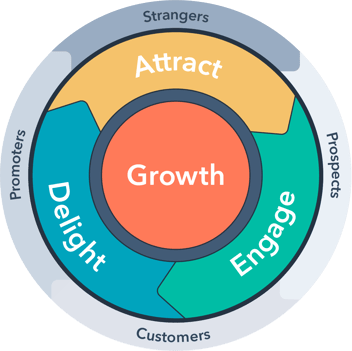So, you want to learn a little more about inbound marketing?
Congratulations! You’re on the way to joining the 71% of organisations that already utilise an Inbound approach to their marketing and benefit from increased lead generation.
Inbound turns traditional marketing practices on its head, eliminating outdated methods such as cold-calling and replacing them with a valuable content strategy that educates and nurtures your leads until they are ready to purchase.
In order to provide this, inbound marketing is built upon four fundamental pillars, each of which plays an equal role in producing marketing excellence.
Sounds complicated? Well, we’re here to shed some more light on these pillars. Master these, and you’ll be on the way to enhancing your revenue and growing your business in no time.
Pillar 1: System
Every inbound marketer loves one thing: statistics. Call us nerds, but our best work is done when we’re analysing existing marketing strategies and identifying opportunities for improvements.
Measuring which areas of your marketing are performing well is crucial to identifying what is delighting leads and coming up with ways to build upon your successes. However, you can’t just pull this data out of the air.
You need a system that measures the effectiveness of every element of your marketing strategy, from blog performance to email open rates. Embracing analytics is also a great way to gain an edge on your competitors, with only 22% of marketers having data-driven initiatives that achieve significant results.
HubSpot provides an industry-leading digital platform that allows you to coordinate every aspect of your inbound marketing and sales in one place.
It is not much use having all the behind-the-scenes software without the website to use it though. At Digital Media Stream, we specialise in Growth-Driven Design (GDD), and create websites that provide an exceptional user experience in alignment with your inbound strategy.
While traditional website design delivers a website built on assumptions, GDD uses real-time user data to continually update your web presence to suit your customers and grow with them.
Pillar 2: Customer Profiles
Once you have your inbound marketing system in place, it is time to ask yourself a very important question: what does your ideal customer really want?
This is one of the most underrated questions in marketing and all too often businesses don’t give it the time it deserves. A company that manufactures trainers may be tempted to simply answer ‘trainers’, but this won’t help you stand out in a crowded marketplace.
To answer this question then, you need to create detailed customer profiles. These profiles are fictional representations of your ideal buyer and the more in-depth they are, the more targeted your inbound marketing can be. It is suggested that three to four profiles usually account for 90% of sales, so identifying the right customers is key.
Personal and professional characteristics come into play here, such as their age, job status and average salary. More than this, though, you’ll want to identify the challenges and barriers they are facing when they come to purchasing.
Continuing with our trainer example, you may, when creating your customer profiles, identify that your customers are concerned about the ethical sourcing of leather. With this information, you can create a marketing strategy around ethical trainer materials that educates them and demonstrates that your product is suitable for them.
Despite the obvious benefits, only 44% of B2B marketers are using customer profiles, so creating your own could give your business a significant advantage over your competition.
Every challenge you discover your target customers are facing is another potential point of contact between them and your business and another opportunity to provide value to your consumers through inbound marketing.
Pillar 3: Strategy
Now you have your system and customer profiles it is time to think about the pathway you want your leads to take, all the way from stranger to customer.
Obviously, in a dream world, every person who visits your website would be ready to buy, but in reality, leads will need to be inspired to purchase by the valuable content inbound marketing provides. After all, 81% of shoppers conduct online research before making big purchases.
When creating an inbound marketing strategy, you’ll need to plan valuable content for each of your personas, to take them through the buyer’s journey. This includes:
- Awareness content, which suits people who are just beginning to identify the challenges they are facing.
- Consideration content designed to help people learn more about the product or service they are looking at purchasing.
- Decision content that targets those who have decided to purchase and are now choosing which company to give their business to.
By creating content for each these, you ensure that anyone who explores your business benefits from your expertise and begins to build a relationship with your brand. This lead nurturing has been seen to result in a 50% increase in sales-ready leads.
Hold on though. We keep talking about content, and so far haven’t gone into much detail. As part of your strategy development, you’ll get to choose from a buffet of inbound marketing content types, but here are the major ones:
- Blog posts: Blogs are a crucial element of inbound marketing, providing you with the space you need to regularly produce valuable content that attracts new leads.
- Offers: Once your leads are hooked, you’ll want to learn a little more about them, such as job titles, company names and email addresses. To do this, inbound marketing goes the extra mile to provide educational, extensive offer content in the form of eBooks, infographics or more in exchange for this information.
- Calls-to-action (CTAs): CTAs provide the bridge between your blog and offer content, moving people from strangers to marketing-qualified leads (MQLs)
- Email: Users leaving your website without purchasing? Don’t worry, it’s not the end of their journey to becoming a customer, in fact, it’s just the beginning. Inbound uses personalised email marketing to continue to nurture leads and improve your customer conversion rate.
Pillar 4: Iterative Campaign Execution
Now we come to the really exciting part of inbound. You’ve put everything in place and now you can watch your marketing flourish.
If you’ve already begun exploring the topic of inbound, you may have noticed that some marketing agencies claim they can offer effective campaign execution from day one.
As you have already seen from this blog, inbound marketing demands impressive levels of detail. Without a system, you cannot measure return on investment (ROI); without customer profiles, you cannot create targeted content; and without a strategy, you cannot move people through the buyer’s journey.
Only with all four pillars does your inbound marketing strategy stand tall and deliver ROI.
Iterative campaign execution encompasses the creation of all the content you require to begin generating more leads. As previously mentioned, inbound marketing’s greatest asset is its use of analytics to measure the effectiveness of your efforts.
Therefore, it is in the campaign execution stage that you’ll see your inbound team really begin their testing. Every blog, web page, offer, email or social media post will undergo extensive data analysis.
From this, you’ll gather new insights into everything from what email subject lines encourage the most opens, to the types of language and tones that resonate best with your customers.
Armed with this information, your inbound marketing can be revised and enhanced so it continues to go from strength to strength, along with your lead generation and customer numbers.
If your business wants to generate more leads and convert them into customers, you may be ready to benefit from the four pillars of inbound marketing.
To learn more about how Digital Media Stream can create a tailored inbound solution for your business, book a free Marketing Assessment with one of our experts and discover how we can help you achieve your growth goals.




